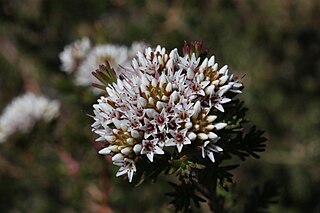
The Rhamnaceae are a large family of flowering plants, mostly trees, shrubs, and some vines, commonly called the buckthorn family. Rhamnaceae is included in the order Rosales.
Alfred Karl Meebold was a botanist, writer, and anthroposophist.

Trymalium is a genus of shrubs or trees in the family Rhamnaceae. The species are endemic to Western Australia but for one, Trymalium wayi, that occurs in South Australia. They are found in forest and semiarid woodland and shrubland of the kwongan in southwest Australia, and the outlying species of South Australia is found on rocky slopes, notably at the Mount Lofty and Flinders Ranges.

Darwinia capitellata is a plant in the myrtle family Myrtaceae and is endemic to the south-west of Western Australia. It is a bushy, many-branched shrub, very similar to Darwinia diosmoides but differs in the arrangement of its flowers, its more branched habit, prominent oil glands on the younger stems and its thinner, paper-like bracteoles. It was first discovered as a separate species when specimens of it were found to have a larger chromosome number than specimens of D. diosmoides.

Trymalium odoratissimum is a plant species found in Southwest Australia.

Polianthion is a genus of plants in the Rhamnaceae family, first described by Kevin R. Thiele in 2006. The genus name derives from the Greek polios (grey) and anthion, and describes the small, densely grey-pubescent flowers.
Stenanthemum bremerense is a species of flowering plant in the family Rhamnaceae and is endemic to the southwest of Western Australia. It is an erect, or low spreading shrub with hairy young stems, broadly egg-shaped leaves and densely hairy heads of tube-shaped flowers, sometimes with whitish floral leaves.
Stenanthemum complicatum is a species of flowering plant in the family Rhamnaceae and is endemic to the southwest of Western Australia. It is a woody, erect or straggling shrub with densely hairy young stems, broadly egg-shaped leaves and densely woolly-hairy heads of tube-shaped flowers.
Stenanthemum divaricatum is a species of flowering plant in the family Rhamnaceae and is endemic to the southwest of Western Australia. It is a small, often spiny shrub with sparsely hairy young stems, fan-shaped to narrowly egg-shaped leaves and densely, softly-hairy heads of tube-shaped flowers.

Stenanthemum intricatum is a species of flowering plant in the family Rhamnaceae and is endemic to the southwest of Western Australia. It is an erect to spreading, often wiry shrub with sparsely hairy young stems, egg-shaped to fan-shaped leaves and greyish, densely softly-hairy heads of white or cream-coloured flowers.
Stenanthemum liberum is a species of flowering plant in the family Rhamnaceae and is endemic to the southwest of Western Australia. It is a dwarf or prostrate shrub with densely hairy young stems, elliptic to egg-shaped with the narrower end towards the base, and densely hairy heads of tube-shaped flowers.
Stenanthemum limitatum is a species of flowering plant in the family Rhamnaceae and is endemic to the southwest of Western Australia. It is an erect or straggling shrub with sparsely hairy young stems, egg-shaped to fan-shaped leaves and greyish, softly-hairy heads of white or cream-coloured flowers.
Stenanthemum mediale is a species of flowering plant in the family Rhamnaceae and is endemic to inland Western Australia. It is an erect shrub with densely hairy young stems, egg-shaped leaves and densely hairy heads of silvery to rust-coloured flowers.

Stenanthemum nanum is a species of flowering plant in the family Rhamnaceae and is endemic to the south-west of Western Australia. It is a prostrate shrub with hairy young stems, broadly egg-shaped leaves with the narrower end towards the base, and densely silvery-hairy heads of white or cream-coloured flowers.
Stenanthemum newbeyi is a species of flowering plant in the family Rhamnaceae and is endemic to a restricted area in the south of Western Australia. It is an erect or spreading shrub with hairy young stems, egg-shaped leaves with the narrower end towards the base, and clusters of rust-coloured, densely shaggy-hairy flowers, surrounded by whitish floral leaves.
Stenanthemum notiale is a species of flowering plant in the family Rhamnaceae and is native to Western Australia, South Australia and Victoria. It is a small, erect to prostrate shrub with hairy young stems, egg-shaped leaves with the narrower end towards the base, and clusters of white to cream-coloured or greenish yellow, densely shaggy-hairy flowers.
Stenanthemum patens is a species of flowering plant in the family Rhamnaceae and is endemic to the inland of Western Australia. It is a small shrub with densely hairy young stems and a few spines, egg-shaped to broadly egg-shaped leaves with the narrower end towards the base, and densely hairy clusters of tube-shaped flowers.
Stenanthemum petraeum is a species of flowering plant in the family Rhamnaceae and is native to inland Western Australia and the Northern Territory. It is a woody, erect shrub with densely hairy young stems, broadly egg-shaped to more or less round leaves, and clusters of white, densely shaggy- to woolly-hairy flowers.

Stenanthemum pumilum is a species of flowering plant in the family Rhamnaceae and is endemic to the southwest of Western Australia. It is a low, compact shrub with hairy young stems, egg-shaped leaves, sometimes with the narrower end towards the base, and clusters of 10 to 30 white to creamy-white, woolly hairy, tube-shaped flowers.
Stenanthemum sublineare is a species of flowering plant in the family Rhamnaceae and is endemic to the southwest of Western Australia. It is an erect shrub with sparsely hairy young stems, narrowly egg-shaped to linear leaves, and small clusters of densely hairy, greenish, tube-shaped flowers.






